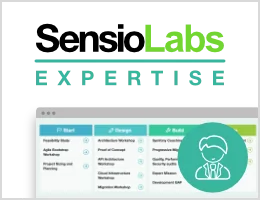How to Import Configuration Files/Resources
Tip
In this section, service configuration files are referred to as resources. While most configuration resources are files (e.g. YAML, XML, PHP), Symfony is able to load configuration from anywhere (e.g. a database or even via an external web service).
The service container is built using a single configuration resource
(config/services.yaml by default). This gives you absolute flexibility over
the services in your application.
External service configuration can be imported in two different ways. The first
method, commonly used to import other resources, is via the imports
directive. The second method, using dependency injection extensions, is used by
third-party bundles to load the configuration. Read on to learn more about both
methods.
Importing Configuration with imports
By default, service configuration lives in config/services.yaml. But if that
file becomes large, you're free to organize into multiple files. Suppose you
decided to move some configuration to a new file:
1 2 3 4 5 6
# config/services/mailer.yaml
parameters:
# ... some parameters
services:
# ... some services1 2 3 4 5 6 7 8 9 10 11 12 13 14 15
<!-- config/services/mailer.xml -->
<?xml version="1.0" encoding="UTF-8" ?>
<container xmlns="http://symfony.com/schema/dic/services"
xmlns:xsi="http://www.w3.org/2001/XMLSchema-instance"
xsi:schemaLocation="http://symfony.com/schema/dic/services
https://symfony.com/schema/dic/services/services-1.0.xsd">
<parameters>
<!-- ... some parameters -->
</parameters>
<services>
<!-- ... some services -->
</services>
</container>1 2 3 4
// config/services/mailer.php
// ... some parameters
// ... some servicesTo import this file, use the imports key from any other file and pass either
a relative or absolute path to the imported file:
1 2 3 4 5 6 7 8 9 10 11 12 13 14 15
# config/services.yaml
imports:
- { resource: services/mailer.yaml }
# If you want to import a whole directory:
- { resource: services/ }
services:
_defaults:
autowire: true
autoconfigure: true
App\:
resource: '../src/*'
exclude: '../src/{DependencyInjection,Entity,Migrations,Tests,Kernel.php}'
# ...1 2 3 4 5 6 7 8 9 10 11 12 13 14 15 16 17 18 19 20 21 22
<!-- config/services.xml -->
<?xml version="1.0" encoding="UTF-8" ?>
<container xmlns="http://symfony.com/schema/dic/services"
xmlns:xsi="http://www.w3.org/2001/XMLSchema-instance"
xsi:schemaLocation="http://symfony.com/schema/dic/services
https://symfony.com/schema/dic/services/services-1.0.xsd">
<imports>
<import resource="services/mailer.xml"/>
<!-- If you want to import a whole directory: -->
<import resource="services/"/>
</imports>
<services>
<defaults autowire="true" autoconfigure="true"/>
<prototype namespace="App\" resource="../src/*"
exclude="../src/{DependencyInjection,Entity,Migrations,Tests,Kernel.php}"/>
<!-- ... -->
</services>
</container>1 2 3 4 5 6 7 8 9 10 11 12 13 14 15 16 17
// config/services.php
namespace Symfony\Component\DependencyInjection\Loader\Configurator;
return function(ContainerConfigurator $container): void {
$container->import('services/mailer.php');
// If you want to import a whole directory:
$container->import('services/');
$services = $container->services()
->defaults()
->autowire()
->autoconfigure()
;
$services->load('App\\', '../src/*')
->exclude('../src/{DependencyInjection,Entity,Migrations,Tests,Kernel.php}');
};When loading a configuration file, Symfony loads first the imported files and
then it processes the parameters and services defined in the file. If you use the
default services.yaml configuration
as in the above example, the App\ definition creates services for classes
found in ../src/*. If your imported file defines services for those classes
too, they will be overridden.
A possible solution for this is to add the classes and/or directories of the
imported files in the exclude option of the App\ definition. Another
solution is to not use imports and add the service definitions in the same file,
but after the App\ definition to override it.
Note
Due to the way in which parameters are resolved, you cannot use them to build paths in imports dynamically. This means that something like the following does not work:
1 2 3
# config/services.yaml
imports:
- { resource: '%kernel.project_dir%/somefile.yaml' }1 2 3 4 5 6 7 8 9 10 11
<!-- config/services.xml -->
<?xml version="1.0" encoding="UTF-8" ?>
<container xmlns="http://symfony.com/schema/dic/services"
xmlns:xsi="http://www.w3.org/2001/XMLSchema-instance"
xsi:schemaLocation="http://symfony.com/schema/dic/services
https://symfony.com/schema/dic/services/services-1.0.xsd"
>
<imports>
<import resource="%kernel.project_dir%/somefile.yaml"/>
</imports>
</container>1 2 3 4 5 6
// config/services.php
namespace Symfony\Component\DependencyInjection\Loader\Configurator;
return static function (ContainerConfigurator $container): void {
$container->import('%kernel.project_dir%/somefile.yaml');
};Importing Configuration via Container Extensions
Third-party bundle container configuration, including Symfony core services, are usually loaded using another method: a container extension.
Internally, each bundle defines its services in files like you've seen so far.
However, these files aren't imported using the import directive. Instead, bundles
use a dependency injection extension to load the files automatically. As soon
as you enable a bundle, its extension is called, which is able to load service
configuration files.
In fact, each configuration file in config/packages/ is passed to the
extension of its related bundle - e.g. FrameworkBundle or TwigBundle -
and used to configure those services further.

